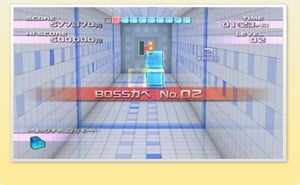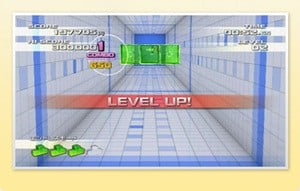
One doesn't often think of thrills and puzzles as belonging in the same sentence. You can get a bit of excitement from kicking off a combo in a fast-paced game, but to actually get a rush in the same sense as riding a rollercoaster is something else entirely.
Whilst it might be an exaggeration to say Surinuke Anatōsu is the equivalent of an amusement park ride, the level of excitement generated is certainly closer to that kind of experience than racking up a multi-chain combo in a game of Puyo Puyo, thanks to a nearly first-person perspective and emphasis on speed and reflexes over the usual colour-matching concepts found in most puzzlers.
When we first reported on Nintendo's newest Japanese WiiWare release, we compared it to the classic arcade puzzler Block Out – essentially a 3D version of Tetris in which players are tasked with clearing the bottom of a well-like playfield by putting together layers of falling 3D tetronimos. In fact, the similarity in Surinuke Anatōsu ends with the use of 3D tetronimos, as the Japanese verb "surinukeru" means to slip through or out of something rapidly, and in this game you're trying to guide a single shape through a series of eleven panels past holes of various sizes and positions within a fixed time limit.

Given that you're still manipulating a 3D object, the controls are quite similar to Block Out, as is the challenge in wrapping your head around them: you move the tetronimo in a 2D plane using either  or
or  (Remote, Remote + Nunchuk and Classic Controller/Pro are all supported), separate buttons rotate it on each of the three axes whilst a fourth button will accelerate your shape towards its destiny.
(Remote, Remote + Nunchuk and Classic Controller/Pro are all supported), separate buttons rotate it on each of the three axes whilst a fourth button will accelerate your shape towards its destiny.
Though you can play with just the Remote on its side, we found trying to coordinate presses of all four primary buttons to be a bit much and ended up using the Classic Controller Pro, where ZL speeds your shape up and rotation is achieved using a combination of the R button and the right  – though you can also use the A and B buttons. Helping you get to grips with all of this is a multi-part hands-on tutorial which handily changes button prompts depending upon which control scheme you're using (peripherals are automatically detected as connected – nice).
– though you can also use the A and B buttons. Helping you get to grips with all of this is a multi-part hands-on tutorial which handily changes button prompts depending upon which control scheme you're using (peripherals are automatically detected as connected – nice).
There are three modes of play on offer, the first of which is Stage Clear, in which you progress through six stages of three levels each. Each stage has a unique shape that increases in complexity as you advance. You only get to play the next stage by clearing all three levels in the previous one; clearing stages in this mode makes their associated shapes available for use in the other game modes. Your most basic goal is simply to get your shape through one of the holes in the numbered panel in front of you, repeating through the following series with a few simple bonus panels here and there for good measure. If you cannot line up your shape properly, it will break into pieces. You can only let this happen a few times (three in some of the easier levels, but many only give you two or even one chance to blow it) before your game ends. There's also a time limit to urge you along with an audio indicator counting down the final ten seconds.

Of course, just sticking to the basics won't get you a high score, and you'll need to beat the local high score for each level before you get prompted to register it on the "worldwide" (hint-hint, global release) leaderboard, which means racking up "combos" and "tricks." A panel will usually have two holes in it containing one or more gems in each; every time your shape passes through part of the hole containing one or more gems, you'll build a combo which increases until you miss a gem. Moving your shape so that it overlaps all of the spaces in a given hole before it goes through will count as a trick, and, as with consecutive gem collection, pulling off repeated tricks will build your "trick combo." Both combo types contribute to separate bonus point caches that get added to your score at the end of the stage. Another way to increase your score is to go through the levels more rapidly by holding down the speed button – though it puts some serious demand on your reflexes if you're going to try something bold like keeping it pressed, as the acceleration seems to continue the longer you hold it down.
Endless Mode plays the same as Stage Clear, but without the time limit – though getting a Wi-Fi leaderboard score here is pretty demanding. You get four chances to fail, and the holes tend to be a little simpler, so you can generally focus more on speed. This makes for a pretty thrilling time spinning your katamari (as the shapes are called) as it hurtles through wall after wall.
If you want to bone up on your trick combos, there's a Trick Challenge mode in which your katamari cannot pass through the hole in the wall until it's overlapped all of the spaces – a formidable challenge indeed with the last three katamaris, which present greatly different shapes on each side that you can select to face.

Keeping things interesting are some pretty impressive visuals considering the nature of the game: the katamaris appear to be made of glass, which has a nice warping effect as you look through it, though when you move the shape, the individual cubes composing it jiggle slightly as if it were cobbled together from blocks of jelly. The shaft that your shape hurtles through has the look of being tiled in colourful patterns that sometimes appear to be transparent or have gaps, revealing a skyscape or abstract outer environment beyond. Each katamari's group of stages has a unique colour scheme, and you can choose to play other stages among any you've unlocked or have the selection randomly chosen for a bit of variety. The soundtrack consists of a few ambient electronic compositions that nicely complement the overall minimal look whilst sound effects add to the feeling of momentum as you rack up combos and speed through towards the goal.
It's always nice to see that something new can be done in the puzzle genre, and we hope that fans will give this game due consideration when it eventually shows up on other shores. Perhaps we'll still have a few top ten scores in the rankings by then!
Comments 5
I'd like to see some video footage,seems interesting enough.
looks like something I could dominate in. jk. gonna have to keep an eye on this one though.
@odd69: you can see loads of video at the Japanese Nintendo site for this game: http://www.nintendo.co.jp/wii/wiiware/w3kj/index.html
I heard it will be called "ThruSpace: High Velocity Puzzle" when it comes to the west.
Sounds (and looks.... just watched the video) pretty good!
Show Comments
Leave A Comment
Hold on there, you need to login to post a comment...